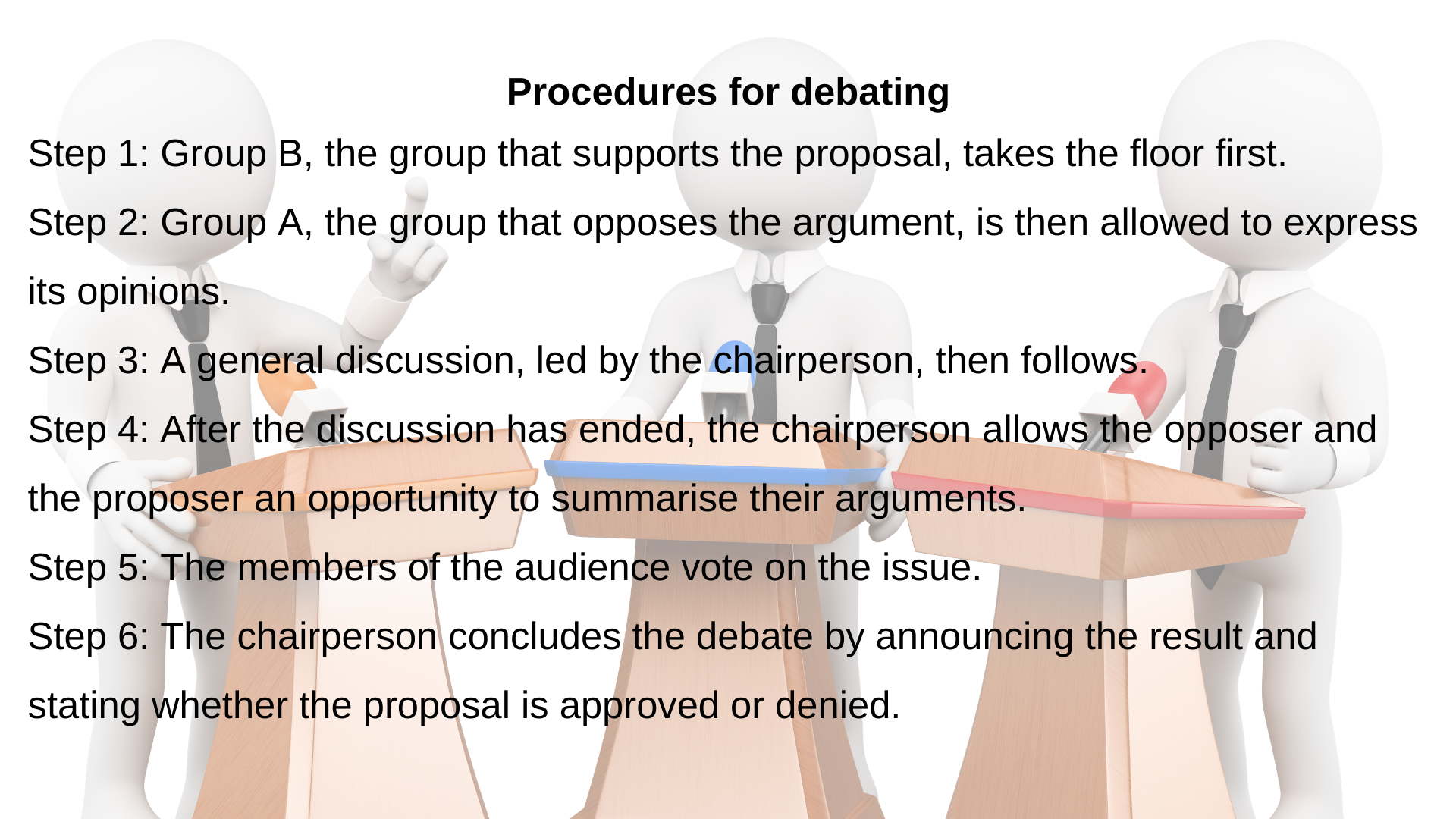The Oxford English Reference Dictionary defines a debate as, “a formal discussion on a particular matter.”
A formal debate on a particular topic can appear on the agenda of a formal meeting or it can be a separate meeting where one topic is discussed.
Debates can also be informal, as issues where there is discussion and disagreement can arise at any time during your day at work or at home.
If you wish to communicate effectively in a formal debate, then you need to know how to participate.
Procedures for Debating

In a formal debate there are two groups who hold differing opinions of the topic under discussion. Let’s consider the following example: A company has proposed transferring the Pension Fund into a Provident Fund.
Group A might be against this and want to remain with the Pension Fund; the other, Group B, might support the change to a Provident Fund.
Step 1: Group B, the group that supports the proposal, takes the floor first. A proposer introduces the argument and might say, “We support the proposal to move from a Pension Fund to a Provident Fund.”
Reasons to support the proposal are then put forward by the proposer and/or other members of the group.
Points to remember:
You are trying to persuade people to support your point of view, so:
- Emphasise the points that support the move to the Provident Fund;
- Make use of persuasive language; and
- Use your voice and non-verbal communication to emphasise that the move to a Provident Fund is a good idea.
Step 2: Group A, the group that opposes the argument, is then allowed to express its opinions. Following the same procedure, the opposed states, “We believe that moving to a Provident Fund is not in the interests of the employees of this company.”
Reasons for opposing the proposal are then put forward by the opposed and/or other members of the group.
Points to remember:
The opposed is also trying to persuade people to support his/her point of view, so:
- Emphasise why the move to the Provident Fund is not a good idea and why the company should remain with the Pension Fund;
- Make use of persuasive language; and
- Use your voice and non-verbal communication to emphasise that the move to a Provident Fund is not a good idea.
Step 3: A general discussion, led by the chairperson, then follows. The chairperson has to assume the roles and responsibilities of the group leader and it is important for the chairperson to remain impartial. That is, he/she must not take sides.
For example, if the chairperson asked for comments from a particular department, he would not say, “What does management think of the ill-advised move?” If he did, this would show that he was against the move to a Provident Fund.
Instead, he would ask, “What does management think of the proposed move?”
Step 4: After the discussion has ended, the chairperson allows the opposed and the proposer an opportunity to summarise their arguments.
When you summarise your argument, take note of the following:
- The summary should be brief, but powerful;
- Ensure that you emphasise the most important points to support your point of view;
- Make use of persuasive language;
- Use your voice and non-verbal communication to emphasise your proposal;
- End your summary in a strong, effective manner. For example, you would not end by saying, “And so you must vote to stay with the Pension Fund.” Instead, you might say, “In order to ensure we receive the pensions we deserve and have worked hard for, I urge you to reject the ill-advised move to the Provident Fund and vote for the sensible option - remaining with the Pension Fund!”

Step 5: The members of the audience vote on the issue. The chairperson asks the members to vote on the issue. After a debate, this is usually done by a show of hands or by orally answering “yes” or “no.” The chairperson will state, “Those in favour of transferring from a Pension Fund to a Provident Fund, please raise your hand.”
After those votes have been counted, the chairperson then states, “Those who are against the proposal to move from a Pension Fund to a Provident Fund, please raise your hand.”
Step 6:
The chairperson concludes the debate by announcing the result and stating whether the proposal is approved or denied.
For example, “The proposal to transfer the money from a Pension Fund to a Provident Fund has been approved by 367 votes to 220.”
General points for effective communication during a debate:
- Make sure that you clearly understand the proposal under discussion before the debate begins. Reflect on the issue and clarify your side of the argument. Organise your thoughts and jot down the important points.
- Let your opponents express their opinions without interruption and listen carefully to what is said. You might be able to use any faulty points in your opponents’ arguments against them.
- For example, the speaker from the opposing side might have mentioned that the employees will lose money. Make a note of this, so that when you speak you can mention that, in fact, the employees will gain money.
- Present your case calmly and logically. Try not to lose your temper and shout. Calmly stating the facts is more effective than screaming and banging on the table!
- Be polite and do not make statements like, “Nonsense!” or “That’s crazy!”
- If your opponent does this, calmly insist on asking why.
- You can attack your opponents’ case, but never their character.
- You can say, “The proposal is criminal - people are being defrauded and are losing their money!” However, you should not say, “People who support this move are money-grabbing criminals!”

Drawing Conclusions
You have concluded the interview on a positive, friendly note and have explained what the next step will be.
What do you do next?
- It is important for you to take some time immediately after the interview to read over your notes.
- You may need to elaborate on your notes, summarise some answers and/or record factual information. You could record this on an interview record card. (See example below.)
- Review the facts and information that you obtained.
- Make a note of your feelings and impressions.
This process is vital, especially if you conduct several interviews in succession. These detailed, objective notes will help you to remember information about each candidate or employee. They also prove invaluable if you have to share this information with anyone else or if any decisions have to be made.